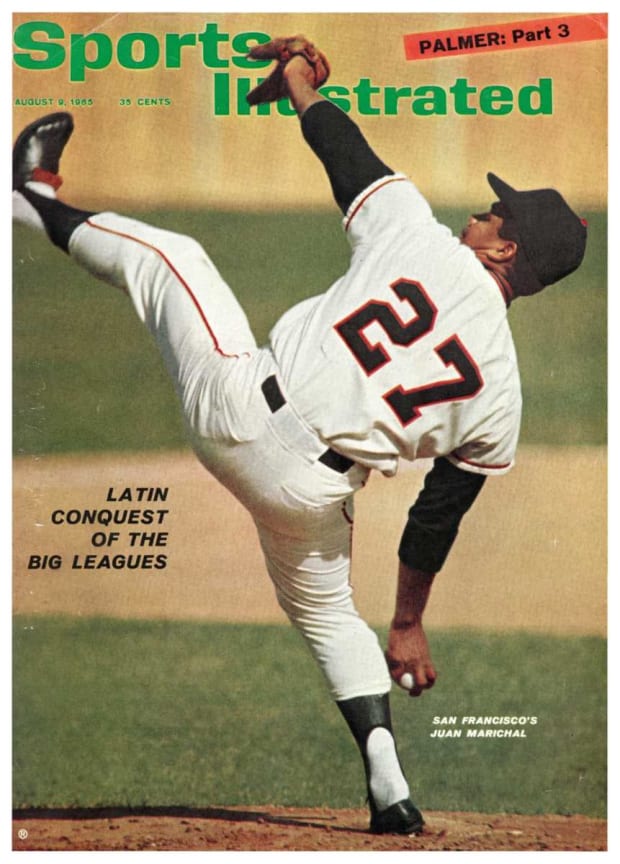Good morning, I’m Dan Gartland. It’s rare for a summer morning to start out with sports news this monumental.
In today’s SI:AM:
🎾 Serena’s impending retirement
🏈 Breaking down the college football schedule
If you're reading this on SI.com, you can sign up to get this free newsletter in your inbox each weekday at SI.com/newsletters.
Goodbye to the GOAT
Serena Williams, the greatest women’s tennis player in history—perhaps the greatest tennis player in history, period—is retiring from the game, but not right this moment.
In a first-person essay for Vogue, Williams explained that she and her husband, Reddit cofounder Alexis Ohanian, want to grow their family. “I’m turning 41 this month, and something’s got to give,” she said. (Williams doesn’t turn 41 until Sept. 26, but the essay appears in Vogue’s September issue.)
Williams wrote she is hesitant to call this next stage in her life “retirement” but confirmed she will transition away from competitive tennis.
I have never liked the word retirement. It doesn’t feel like a modern word to me. I’ve been thinking of this as a transition, but I want to be sensitive about how I use that word, which means something very specific and important to a community of people. Maybe the best word to describe what I’m up to is evolution. I’m here to tell you that I’m evolving away from tennis, toward other things that are important to me. A few years ago I quietly started Serena Ventures, a venture capital firm. Soon after that, I started a family. I want to grow that family.
But I’ve been reluctant to admit to myself or anyone else that I have to move on from playing tennis. Alexis, my husband, and I have hardly talked about it; it’s like a taboo topic. I can’t even have this conversation with my mom and dad. It’s like it’s not real until you say it out loud. It comes up, I get an uncomfortable lump in my throat, and I start to cry. The only person I’ve really gone there with is my therapist! One thing I’m not going to do is sugarcoat this. I know that a lot of people are excited about and look forward to retiring, and I really wish I felt that way. Ashleigh Barty was number one in the world when she left the sport this March, and I believe she really felt ready to move on. Caroline Wozniacki, who is one of my best friends, felt a sense of relief when she retired in 2020.
What isn’t clear is when Williams’s “evolution” will occur. She won her first-round match against Nuria Párrizas Díaz at the Canadian Open yesterday and will face either Tereza Martincová or 12th-seeded Belinda Bencic tomorrow in the second round. She’s also entered to participate in the Western & Southern Open in Cincinnati next week. And while she isn’t officially confirmed for the U.S. Open next month, she does mention in the Vogue piece that she is “going to try” to win in New York.
As much as Serena and the rest of the world would like to see her go out on top, winning the U.S. Open seems like nothing more than a fantasy. Her win yesterday was her first in 430 days, dating back to a third-round win at the 2021 French Open. Barring a miracle, she won’t tie Margaret Court’s record of 24 major championships, but that doesn’t matter. She’s already secured her place among the greatest athletes in history and extinguished all doubts that anyone else could be considered the best women’s tennis player ever. Jon Wertheim said it better than I could in his Daily Cover on Serena from earlier this summer:
Her career has not merely been cinematic, but literary. There is a gripping story, but also larger themes. She has been unmistakably the heroine, the protagonist, but there are rich supporting characters. Her story comes with rising and falling actions, plot points, conflicts and resolutions. Not unlike a tennis match, it can be divided into sections. There was an electric beginning and hefty middle and, so far, a graceful conclusion.
One thing that’s clear from Williams’s essay is she doesn’t intend to retreat from public life. She mentions she’s become increasingly involved in her investment firm, Serena Ventures. Much like how she paved the way for Black tennis players, Williams writes that her company focuses on investing in woman- and minority-led businesses. She sounds like she’s hard at work, so “retirement” certainly doesn’t seem like the right word.
The best of Sports Illustrated

In today’s Daily Cover, Mark Bechtel profiles race car driver Jordan Taylor, who has become famous for his alter ego, Rodney Sandstorm:
He’s turned up all over the racing landscape, he has nearly 20,000 Instagram followers and he had Fox announcer Darrell Waltrip ready to call security when he crashed a live segment on pit road in Talladega, asking [Jeff] Gordon to autograph his shoe. Dale Earnhardt Jr.’s media company, Dirty Mo Media, recently hired him to contribute to a series called Video Jorts. “What blows me away is how many places I see him,” says Gordon. “I tap into social media and see where he is at and I’m going, Oh my God, he’s still pulling this off? I’m certainly not surprised that we did it at an IMSA race that I was participating in, or maybe at a NASCAR race. But when I see him at an F1 event”—Rodney was very popular in Miami this spring—“I just always get a big laugh.”
Rohan Nadkarni has offseason grades for every team in the NBA’s Eastern Conference. … Pat Forde has 40 observations about this year’s college football schedule. … Albert Breer checks in from Rams camp, where the focus is on the wide receivers.
Around the sports world
Kevin Durant has reportedly told the Nets that they’ll have to choose between him and the pairing of GM Sean Marks and coach Steve Nash. … Nets owner Joe Tsai threw his support behind the front office. … Baker Mayfield is reportedly the favorite to win the Panthers’ starting QB job. … The Ravens have locked up kicker Justin Tucker with a big contract extension. … Because WNBA players are still flying commercial for some reason, Sparks players had to sleep in the airport after their flight got canceled, and there wasn’t enough room at the hotel. … Matt Carpenter, who’s having a surprisingly excellent season for the Yankees, broke his foot after hitting himself with a foul ball.
SIQ
The Oilers traded Wayne Gretzky to the Kings on this day in 1988, but he almost got sent elsewhere. Which of the following cities has Gretzky not said was a contender to land him?
- Detroit
- Boston
- Philadelphia
- New York
Yesterday’s SIQ: How many games did the 1976 White Sox play wearing shorts?
Answer: Three. In addition to the Aug. 8 game against the Royals, they also wore them for two games against the Orioles on Aug. 21 and 22.
The idea came from—who else?—eccentric White Sox owner Bill Veeck, who in March of that year revealed the team’s new uniforms for the upcoming season. From 1971 to ’75, the White Sox wore white uniforms with red pinstripes at home and baby-blue uniforms with red accents on the road. For the ’76 season, Veeck completely overhauled the uniforms. The home sets were white, while the road sets were navy blue. Both versions of the uniform featured old-fashioned block letters and enormous spread collars. Oh, and then there were the shorts.
Veeck pitched the shorts as being good for hot weather, but it took the team until August to finally break them out. When they finally did, they won two out of the three games they played in them. (Not bad for a team that lost 97 games.)
The common misconception about the shorts is that players were unwilling or unable to slide in them. But as Uni Watch’s Paul Lukas pointed out in 2016, the Sox actually stole eight bases during those three games. Lukas also dug up several examples of other teams that experimented with shorts, including the Double A Knoxville White Sox, who got the big league club’s uniforms as hand-me-downs.
From the Vault: Aug. 9, 1965

Neil Leifer/Sports Illustrated
First of all, how cool is that photo of Hall of Fame Giants pitcher Juan Marichal? You just don’t see guys with big leg kicks like that anymore.
And just as big leg kicks are uncommon today, before Marichal’s day, players from Latin America were uncommon in the major leagues. But that was changing in the 1960s, which was the subject of Robert H. Boyle’s cover story:
In Puerto Rico, Venezuela, Panama, Nicaragua, the Virgin Islands, the revolution-torn Dominican Republic and even Communist Cuba baseball is the most popular sport, as the swelling number of Latin players in the majors clearly indicates. In 1948 there was only one Latin playing regularly in the majors—Mike Guerra of the Philadelphia Athletics. Now there are 48, some of them among the biggest stars in the game, players like Juan Marichal (see cover) of the San Francisco Giants, the best right-hander in baseball, his teammate Orlando Cepeda, and both of last year’s batting champions, Roberto Clemente of Pittsburgh and Tony Oliva of Minnesota.
Boyle including the Virgin Islands took me by surprise. Not only are the Virgin Islands not part of Latin America, they aren’t the same kind of baseball hotbed as the other countries he listed. But at the time, there were two outstanding players from the Islands in the majors: Joe Christopher, who batted .300 for the Mets in 1964, and Al McBean, who had a 1.91 ERA in ’64 and a 2.29 ERA in ’65 as a reliever with the Pirates.
But Christopher and McBean’s careers were not the start of a big influx of Virgin Islanders in the majors. There have been only 15 players born in the U.S. Virgin Islands who have appeared in a big league game. (Three of them—Akeel Morris, Jabari Blash and Jharel Cotton—have debuted in the past decade.)
Players from Spanish-speaking countries are the focus of Boyle’s story, though. And, given when it was written, it isn’t terribly surprising to see the article is full of racist stereotypes, some of which persist today:
Baseball may be a team sport, but to the dismay of American baseball men, Latins sometimes play with a reckless individuality. Indeed it is the individuality in baseball that they like. “The great appeal of the game to the Latin is the chance to show himself,” says [Spanish-language announcer Buck] Canel. “Essentially, baseball is a duel between two men, the pitcher and the batter. Latins realize that baseball is a team effort technically, but for every player there is that moment for individual glory, to hit a home run, to win the game or the chance to strike out a guy with the bases loaded.”
Boyle goes on to describe at some length the supposed differences between players from various Spanish-speaking countries. But if you can look past the backward portions, it’s an interesting story about some early Latin American baseball pioneers. (It also led me to find a cool article about Canel, the announcer quoted above.)
Check out more of SI’s archives and historic images at vault.si.com.







